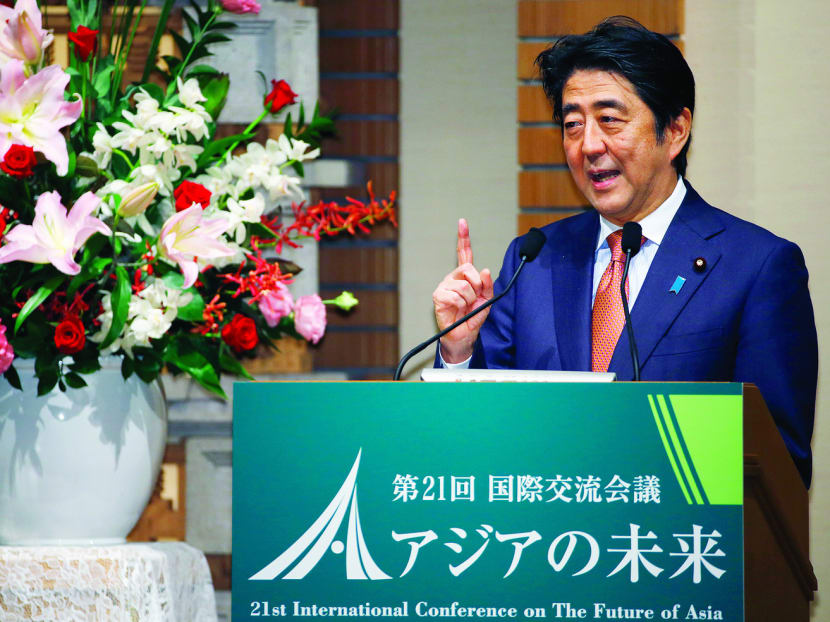Faced with AIIB, Japan to pump S$147b into ADB
TOKYO — Japanese Prime Minister Shinzo Abe announced yesterday that Japan will inject US$110 billion (S$147 billion) into the Asian Development Bank (ADB) to help develop “quality infrastructure” in Asia over the next five years, giving a boost to the multilateral lender just as China is finalising operating arrangements for rival Asian Infrastructure Investment Bank (AIIB).

Japanese Prime Minister Shinzo Abe speaks during a banquet of a symposium on the “Future of Asia” in Tokyo, Thursday, May 21, 2015. Vying to keep pace with China’s rising influence and economic clout, Japan plans to provide $110 billion to help develop roads, ports and other infrastructure in Asia in the next five years, Prime Minister Abe said Thursday. (AP Photo/Shizuo Kambayashi)
TOKYO — Japanese Prime Minister Shinzo Abe announced yesterday that Japan will inject US$110 billion (S$147 billion) into the Asian Development Bank (ADB) to help develop “quality infrastructure” in Asia over the next five years, giving a boost to the multilateral lender just as China is finalising operating arrangements for rival Asian Infrastructure Investment Bank (AIIB).
The plan to enlarge ADB’s investment footprint in Asia by around 30 per cent will give the Japan-dominated lender a head start in a fast-growing region with enormous infrastructure needs. The move comes amid the rise of Beijing-led AIIB, which Tokyo and Washington have declined to join.
Mr Abe said people in Japan are used to choosing good-quality products that last a long time, even if prices are a bit high. “In the long run, we would like to spread quality infrastructure and innovative infrastructure in Asia,” he said in a speech in Tokyo.
To pursue not only quality but quantity, the Japanese government will fund projects in cooperation with the ADB, which is led by Japan and the United States. At the same time, Japan will aim to draw money from the private sector in addition to public funds, he said.
Mr Abe said Japan “highly welcomes” the ADB’s move to boost lending capacity, consider further increasing its capital and expand lending to the private sector. To expand investment, the government-backed Japan Bank for International Cooperation (JBIC) will create a new programme to finance risky projects, though JBIC has so far provided funds for such projects only if they have guarantees from local governments, Mr Abe said.
He said Japan wants to share the technology and experience it acquired from tackling issues such as poor energy resources and an ageing population.
While major European countries such as the United Kingdom and Germany have signed up for the AIIB, Japan and the US have stayed out of the project. Washington, in particular, has cautioned countries against joining the bank — seen as a rival to the US-dominated World Bank — citing what it has called a lack of transparency, doubts about lending and concern over Beijing’s influence.
Japan’s move to inject capital into the ADB is seen as an intention to show its capabilities in infrastructure development.
The China-led AIIB is set to be launched by the end of this year with 57 founding members. AIIB founding members are holding a three-day meeting in Singapore this week to discuss operational policies for the establishment of the institution. Today is the last day of the meeting.
Among the issues on the table is lifting the initial capital from the earlier-planned level of around US$50 billion, said meeting participants. China’s investment ratio, initially anticipated to be around 50 per cent, could be less than 30 per cent as more countries have pledged to contribute to the start-up capital.
The ADB spends around US$13 billion annually to finance infrastructure development. That amount is far smaller than the estimated US$8 trillion required for the region’s infrastructure financing from 2010 to 2020. AGENCIES






